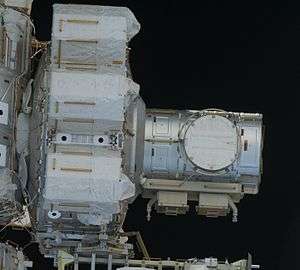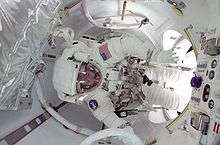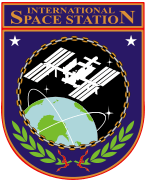Quest Joint Airlock


The Quest Joint Airlock, previously known as the Joint Airlock Module, is the primary airlock for the International Space Station. Quest was designed to host spacewalks with both Extravehicular Mobility Unit (EMU) spacesuits and Orlan space suits. The airlock was launched on STS-104 on July 14, 2001. Before Quest was attached, Russian spacewalks using Orlan suits could only be done from the Zvezda service module, and American spacewalks using EMUs were only possible when a Space Shuttle was docked. The arrival of Pirs docking compartment on September 16, 2001 provided another airlock from which Orlan spacewalks can be conducted.
Design

The Quest Airlock consists of two segments, the "Equipment lock" that stores spacesuits and equipment, and the "Crew Lock" from which astronauts can exit into space.[1] It was derived from the Space Shuttle airlock, although it was significantly modified to waste less atmospheric gas when used. It was attached to the starboard CBM of the Unity during STS-104. It has mountings for four high-pressure gas tanks, two containing oxygen and two containing nitrogen, which provides for atmospheric replenishment to the American side of the space station, most specifically for the gas lost after a hatch opening during a space walk.
Quest was necessary because American suits will not fit through a Russian airlock hatch and have different components, fittings, and connections. The airlock is designed to contain equipment that can work with both types of spacesuits, however, it is currently only able to host American spacewalks because the equipment necessary to work with Russian space suits has not been launched yet, which required the Expedition 9 crew to take a circuitous route to a worksite because of problems with the American space suits.
Camp-out procedure
Quest provides an environment where astronauts can "camp out" before a spacewalk in a reduced-nitrogen atmosphere to purge nitrogen from their bloodstream and avoid decompression sickness in the low-pressure (5 psi, 34 kPa) pure-oxygen atmosphere of the spacesuit.[2] The previous method of preparing for spacewalks involved breathing pure oxygen for several hours prior to an EVA to purge the body of nitrogen. In April 2006, Expedition 12 Commander Bill McArthur and Expedition 13 flight engineer Jeffrey Williams tested a new method of preparing for spacewalks by "camping out", or spending the night, in the Quest Airlock.[3] In the chamber, the pressure was reduced from the normal 14.7 to 10.2 psi (101 to 70 kPa).[2] Four hours into the Expedition 13 crew's sleep period, an error tone prompted mission controllers to cut short the activity, but the test was still deemed a success. American spacewalk activities thereafter have employed the "camp-out" pre-breathing technique.[2][3][4]
High-pressure gas tanks
Two oxygen and two nitrogen high-pressure gas tanks are attached externally to the airlock. These tanks provide a replenishable source of gas to the atmosphere control and supply system and 900 psi (6.2 MPa) oxygen for recharging the space suits (EMUs).
Recharging the high-pressure tanks was accomplished by the Space Shuttle fleet until its retirement. When an orbiter was docked to the station's Pressurized Mating Adapters (PMA-2 or PMA-3), oxygen was routed through pressure lines from the PMAs to the Quest Airlock. The pumping of the oxygen from the docked spacecraft tanks into Quest's high-pressure tank was accomplished by the Oxygen Recharge Compressor Assembly (ORCA).[5] After the retirement of the Space Shuttle fleet, the Nitrogen Oxygen Recharge System (NORS) and spacecraft from the Commercial Orbital Transportation Services (COTS) program will take over this task.[6][7]
Construction
The airlock and tank systems were built out of aluminium and tested at NASA's Marshall Space Flight Center in Huntsville, Alabama by the Boeing Company.
Airlock specifications
- Material: aluminium
- Length: 5.5 meters (18 ft)
- Diameter: 4 meters (13 ft)
- Mass: 6,064 kilograms (13,369 lb)
- Volume: 34 cubic meters (1,200 cu ft)
- Cost: $164 million, including tanks
References
- ↑ NASA (2004). "Space Station Extravehicular Activity". National Aeronautics and Space Administration. Retrieved November 1, 2007.
- 1 2 3 NASA (2006). "Preflight Interview: Joe Tanner". NASA. Retrieved February 8, 2008.
- 1 2 NASA. "Pass the S'mores Please! Station Crew 'Camps Out'". NASA. Retrieved 2006-04-01.
- ↑ NASA. "International Space Station Status Report #06-7". NASA. Retrieved 2006-02-17.
- ↑ NASA. "STS-104 PAYLOADS". NASA. Retrieved 2008-02-21.
- ↑ "International Space Station Environmental Control and Life Support System Status for the Prior Year: 2010–2011" (PDF). NASA. Retrieved 21 November 2012.
- ↑ Brandon, Dick. "Current Status of the Nitrogen Oxygen Recharge System" (PDF). NASA. Retrieved 21 November 2012.
